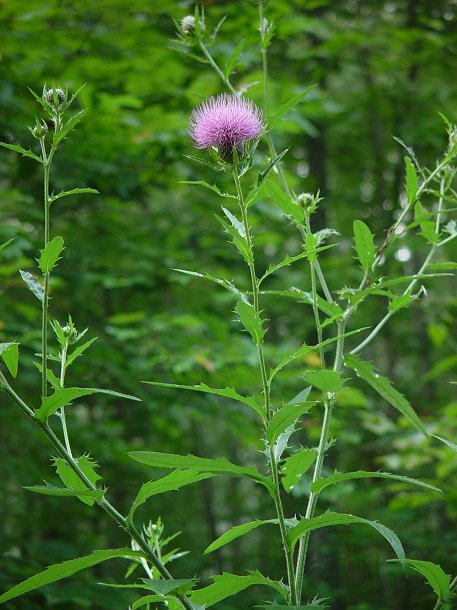Cirsium altissimum (L.) Spreng.
Tall Thistle

Native
CC = 4
CW = 5
MOC = 65
© DETenaglia
Cirsium altissimum (L.) Spreng.Tall Thistle | |
 |
Native CC = 4 CW = 5 MOC = 65 |
© DETenaglia |
|
Family - Asteraceae/Cardueae Habit - Biennial or short-lived perennial forb, often with a slightly thickened taproot in addition to the fibrous roots. Stems - Erect, to 2.5 m, branching, striate, glabrous or sparsely pubescent with spreading hairs, sometimes with patches of white, woolly or felty hairs toward the tip, sometimes appearing slightly glaucous, without spiny-margined wings.
Leaves - Basal and alternate, sessile or short-petiolate. Basal leaves 10-30 cm long, 4-15 cm wide, narrowly ovate to elliptic or obovate, tapered at the base, usually bluntly angled at the tip, unlobed or rarely with several deep lobes, the margins otherwise toothed or wavy and spiny, the upper surface appearing green, nearly glabrous to moderately pubescent with stiff, straight hairs, the undersurface appearing white, densely pubescent with felty hairs. Stem leaves well developed throughout, the main leaves 4-25 cm long, those toward the branch tips usually somewhat reduced, all unlobed or with shallow (less than 1/3 of the way from the margin to midrib), broad lobes (reduced leaves just below the heads rarely more deeply lobed), tapered to a slightly expanded and sometimes minutely decurrent base, otherwise like the basal leaves.
Inflorescence - Solitary heads at branch tips, usually numerous. Heads - Appearing sessile or very short-stalked. Involucre 25-35 mm long, as long as or slightly longer than wide, vase-shaped, often somewhat cobwebby-hairy, Involucral bracts imbricate, appressed, the lower and median bracts tapered to a spreading, spiny tip, this 2-5 mm long, straw-colored to light yellow, usually also somewhat sticky along the midrib. Midrib usually lighter in color.
Ray flowers - Absent. Disc flowers - Corollas 22-32 mm long, pink to reddish purple, tubular, the 5 lobes 6-9 mm long. Pappus of numerous plumose bristles, 17-27 mm long, white or occasionally slightly grayish-tinged. Style well exserted.
Fruits - Achenes 4.5-6.0 mm long. Flowering - July - October. Habitat - Forests, bluff bases, prairies, disturbed sites, roadsides, railroads. Origin - Native to U.S. Lookalikes - Other thistles, e.g. Cirsium undulatum, C. arvense, C. discolor, and others. Other info. - This thistle is common throughout most of Missouri and most of the Midwest. Curiously, it is considered a noxious weed in Iowa. It is easily recognized as a thistle by its spininess and characteristic flowering heads. It is distinguished from other thistle species by its mostly unlobed and undivided leaves, which have felty-white undersides. It also tolerates partial shade better than most other species of Cirsium and will often be found in lightly wooded areas.
Photographs taken in the Ozark Scenic Riverways, Shannon County, MO., 8-9-03 (DETenaglia); also at Cuivre River State Park, Lincoln County, MO, 8-23-2008, St. Francois State Park, St. Francois County, MO, 8-8-2009, Weldon Spring Conservation Area, St. Charles County, MO, 8-15-2010, and LaBarque Creek Conservation Area, Jefferson County, MO, 8-28-2018 (SRTurner). |